Factors Affecting Occupants’ Satisfaction in Governmental Buildings: The Case of the Kingdom of Bahrain
Abstract
1. Introduction
Scope of the Study
2. Research Methodology
3. Results and Discussion
3.1. Occupants’ Characteristics and Building Attributes
3.2. Levels of Occupants’ Satisfaction
3.3. Differences in Occupants’ Satisfaction Levels Due to Non-IEQ Factors
3.3.1. Gender
3.3.2. Age
3.3.3. Job Category
3.3.4. Office Layout
3.3.5. Duration in Building and Duration at the Current Workstation (Office)
3.3.6. Time Spent at Workspace per Week
3.3.7. Distance to Window
3.3.8. Ventilation System
4. Conclusions
- Occupants in the Bahraini governmental buildings are not strongly satisfied with their workplaces. The findings also showed that the lowest satisfaction levels were with sound privacy, then visual privacy and amount of space, and then noise levels;
- The study revealed that gender, office layout, and ventilation system are affecting most of the IEQ factors. Additionally, it showed that privacy factors (visual and sound) and cleanliness factors (workspace and building) are the most affected IEQ factors by the differences in non-IEQ factors;
- Male participants have higher levels of satisfaction than female participants in all IEQ factors. The greatest gaps in satisfaction levels were found in satisfaction with temperature, air quality, and cleanliness factors. This confirms the results of the previous studies, which found that women have a higher sensitivity to thermal conditions and a higher prevalence of being under the risk of SBS symptoms;
- The highest levels of satisfaction with most IEQ factors were in enclosed private offices, and the lowest was in the open offices with no partitions, where occupants were strongly dissatisfied with sound privacy, visual privacy, and amount of space;
- Central air-conditioning is useful to achieve higher levels of satisfaction for most IEQ factors when it is compared with a wall-mounted air conditioner. The only exception in this rule is satisfaction with temperature;
- For the other non-IEQ factors, the study found that the middle age group (30–50 years) is significantly less satisfied than the other groups with temperature, air quality, adjustability of furniture, and building and workplace cleanliness. Additionally, the job category significantly influences satisfaction with temperature, air quality, sound and visual privacy, building and workspace cleanliness, and building maintenance. Further, those who have been working in the buildings for less than one year have statistically significantly higher levels of satisfaction with visual privacy, building and workspace cleanliness, adjustability of furniture, and ease of interaction. Those who are closer to the window have statistically significant levels of satisfaction than those who are seated away with visual privacy, sound privacy, visual comfort, noise level, and amount of light. Finally, the influence of weekly working hours and duration at the current workstation were found insignificant for most IEQ factors.
Author Contributions
Funding
Institutional Review Board Statement
Informed Consent Statement
Data Availability Statement
Conflicts of Interest
References
- Bourikas, L.; Gauthier, S.; En, N.K.S.; Xiong, P. Effect of Thermal, Acoustic and Air Quality Perception Interactions on the Comfort and Satisfaction of People in Office Buildings. Energies 2021, 14, 333. [Google Scholar] [CrossRef]
- Bortolini, R.; Forcada, N. Association between Building Characteristics and Indoor Environmental Quality through Post-Occupancy Evaluation. Energies 2021, 14, 1659. [Google Scholar] [CrossRef]
- Chen, C.-F.; Yilmaz, S.; Pisello, A.L.; De Simone, M.; Kim, A.; Hong, T.; Bandurski, K.; Bavaresco, M.V.; Liu, P.-L.; Zhu, Y. The impacts of building characteristics, social psychological and cultural factors on indoor environment quality productivity belief. Build. Environ. 2020, 185, 107189. [Google Scholar] [CrossRef]
- Leccese, F.; Rocca, M.; Salvadori, G.; Belloni, E.; Buratti, C. Towards a holistic approach to indoor environmental quality assessment: Weighting schemes to combine effects of multiple environmental factors. Energy Build. 2021, 245, 111056. [Google Scholar] [CrossRef]
- Apte, M.G.; Fisk, W.J.; Daisey, J.M. Associations Between Indoor CO2 Concentrations and Sick Building Syndrome Symptoms in U.S. Office Buildings: An Analysis of the 1994-1996 BASE Study Data. Indoor Air 2000, 10, 246–257. [Google Scholar] [CrossRef]
- Al Horr, Y.; Arif, M.; Kaushik, A.; Mazroei, A.; Katafygiotou, M.; Elsarrag, E. Occupant productivity and office indoor environment quality: A review of the literature. Build. Environ. 2016, 105, 369–389. [Google Scholar] [CrossRef]
- Al Horr, Y.; Arif, M.; Katafygiotou, M.; Mazroei, A.; Kaushik, A.; Elsarrag, E. Impact of indoor environmental quality on occupant well-being and comfort: A review of the literature. Int. J. Sustain. Built Environ. 2016, 5, 1–11. [Google Scholar] [CrossRef]
- Fisk, W.J.; Lei-Gomez, Q.; Mendell, M.J. Meta-analyses of the associations of respiratory health effects with dampness and mold in homes. Indoor Air 2007, 17, 284–296. [Google Scholar] [CrossRef]
- de Dear, R.J.; Brager, G.S. Thermal comfort in naturally ventilated buildings: Revisions to ASHRAE Standard 55. Energy Build. 2002, 34, 549–561. [Google Scholar] [CrossRef]
- Kian, P.S.; Feriadi, H.; Sulistio, W.; Seng, K.C. A case study on total building performance evaluation of an intelligent office building in Singapore. Civ. Eng. Dimens. 2004, 3, 9–15. [Google Scholar]
- Assimakopoulos, V.D.; Helmis, C.G. On the study of a sick building: The case of Athens Air Traffic Control Tower. Energy Build. 2004, 36, 15–22. [Google Scholar] [CrossRef]
- Bako-Biro, Z.; Wargocki, P.; Weschler, C.J.; Fanger, P.O. Effects of pollution from personal computers on perceived air quality, SBS symptoms and productivity in offices. Indoor Air 2004, 14, 178–187. [Google Scholar] [CrossRef] [PubMed]
- Simonson, C.J.; Salonvaara, M.; Ojanen, T. The effect of structures on indoor humidity--possibility to improve comfort and perceived air quality. Indoor Air 2002, 12, 243–251. [Google Scholar] [CrossRef] [PubMed]
- Wang, S.; Ang, H.; Tade, M.O. Volatile organic compounds in indoor environment and photocatalytic oxidation: State of the art. Environ. Int. 2007, 33, 694–705. [Google Scholar] [CrossRef]
- Wolkoff, P.; Kjærgaard, S.K. The dichotomy of relative humidity on indoor air quality. Environ. Int. 2007, 33, 850–857. [Google Scholar] [CrossRef]
- Colenberg, S.; Jylhä, T.; Arkesteijn, M. The relationship between interior office space and employee health and well-being—A literature review. Build. Res. Inf. 2021, 49, 352–366. [Google Scholar] [CrossRef]
- Mendell, M.J.; Smith, A.H. Consistent pattern of elevated symptoms in air-conditioned office buildings: A reanalysis of epidemiologic studies. Am. J. Public Health 1990, 80, 1193–1199. [Google Scholar] [CrossRef]
- Hudnell, H.K.; Otto, D.A.; House, D.E.; Mølhave, L. Exposure of Humans to a Volatile Organic Mixture. II. Sensory. Arch. Environ. Health Int. J. 1992, 47, 31–38. [Google Scholar] [CrossRef]
- Wheeler, G.; Almeida, A. These Four Walls: The Real British Office; Gensler Architecture, Design and Planning Worldwide; Taylor & Francis: London, UK, 2005. [Google Scholar]
- Veitch, J.A.; Charles, K.E.; Farley, K.M.; Newsham, G.R. A model of satisfaction with open-plan office conditions: COPE field findings. J. Environ. Psychol. 2007, 27, 177–189. [Google Scholar] [CrossRef]
- Frontczak, M.J.; Schiavon, S.; Goins, J.; Arens, E.; Zhang, H.; Wargocki, P. Quantitative relationships between occupant satisfaction and satisfaction aspects of indoor environmental quality and building design. Indoor Air 2011, 22, 119–131. [Google Scholar] [CrossRef] [PubMed]
- Humphreys, M.A. Quantifying occupant comfort: Are combined indices of the indoor environment practicable? Build. Res. Inf. 2005, 33, 317–325. [Google Scholar] [CrossRef]
- Astolfi, A.; Pellerey, F. Subjective and objective assessment of acoustical and overall environmental quality in secondary school classrooms. J. Acoust. Soc. Am. 2008, 123, 163–173. [Google Scholar] [CrossRef]
- Bluyssen, P.M.; Aries, M.; van Dommelen, P. Comfort of workers in office buildings: The European HOPE project. Build. Environ. 2011, 46, 280–288. [Google Scholar] [CrossRef]
- Lai, A.; Mui, K.; Wong, L.; Law, L. An evaluation model for indoor environmental quality (IEQ) acceptance in residential buildings. Energy Build. 2009, 41, 930–936. [Google Scholar] [CrossRef]
- Wong, L.; Mui, K.; Hui, P. A multivariate-logistic model for acceptance of indoor environmental quality (IEQ) in offices. Build. Environ. 2008, 43, 1–6. [Google Scholar] [CrossRef]
- Sanni-Anibire, M.O.; Hassanain, M.A. Quality assessment of student housing facilities through post-occupancy evaluation. Arch. Eng. Des. Manag. 2016, 12, 367–380. [Google Scholar] [CrossRef]
- Altomonte, S.; Saadouni, S.; Kent, M.G.; Schiavon, S. Satisfaction with indoor environmental quality in BREEAM and non-BREEAM certified office buildings. Arch. Sci. Rev. 2017, 60, 343–355. [Google Scholar] [CrossRef]
- Bae, S.; Asojo, A.O.; Martin, C.S. Impact of occupants’ demographics on indoor environmental quality satisfaction in the workplace. Build. Res. Inf. 2019, 48, 301–315. [Google Scholar] [CrossRef]
- Ren, S.; Dai, L. The Various Factors Affecting Occupants’ Satisfaction in the Open-Plan Shared Office. In Proceedings of the Advances in Intelligent Systems and Computing; Springer: Berlin/Heidelberg, Germany, 2019; pp. 436–446. [Google Scholar]
- Danielsson, C.B.; Bodin, L. Difference in Satisfaction with Office Environment among Employees in Different Office Type. J. Archit. Plann. Res. 2009, 26, 241–257. [Google Scholar]
- Guerin, D.A.; Brigham, J.K.; Kim, H.-Y.; Choi, S.; Scott, A. Post-occupancy evaluation of employees’ work performance and satisfaction as related to sustainable design criteria and workstation type. J. Green Build. 2012, 7, 85–99. [Google Scholar] [CrossRef]
- Kim, J.; de Dear, R.; Cândido, C.; Zhang, H.; Arens, E. Gender differences in office occupant perception of indoor environmental quality (IEQ). Build. Environ. 2013, 70, 245–256. [Google Scholar] [CrossRef]
- Kim, J.; de Dear, R. Workspace satisfaction: The privacy-communication trade-off in open-plan offices. J. Environ. Psychol. 2013, 36, 18–26. [Google Scholar] [CrossRef]
- Schiavon, S.; Altomonte, S. Influence of factors unrelated to environmental quality on occupant satisfaction in LEED and non-LEED certified buildings. Build. Environ. 2014, 77, 148–159. [Google Scholar] [CrossRef]
- Leder, S.; Newsham, G.R.; Veitch, J.A.; Mancini, S.; Charles, K.E. Effects of office environment on employee satisfaction: A new analysis. Build. Res. Inf. 2015, 44, 34–50. [Google Scholar] [CrossRef]
- Choi, J.-H.; Moon, J. Impacts of human and spatial factors on user satisfaction in office environments. Build. Environ. 2017, 114, 23–35. [Google Scholar] [CrossRef]
- Baarspul, H.C.; Wilderom, C.P. Do Employees Behave Differently In Public- Vs Private-Sector Organizations? Public Manag. Rev. 2011, 13, 967–1002. [Google Scholar] [CrossRef]
- Bysted, R.; Hansen, J.R. Comparing Public and Private Sector Employees’ Innovative Behaviour: Understanding the role of job and organizational characteristics, job types, and subsectors. Public Manag. Rev. 2013, 17, 698–717. [Google Scholar] [CrossRef]
- Hansen, J.R. From Public to Private Sector: Motives and explanations for sector switching. Public Manag. Rev. 2013, 16, 590–607. [Google Scholar] [CrossRef]
- Monte, P.A.D. Public versus private sector: Do workers’ behave differently? Economi 2017, 18, 229–243. [Google Scholar] [CrossRef]
- Steel, B.S.; Warner, R.L. Job Satisfaction Among Early Labor Force Participants: Unexpected Outcomes in Public and Private Sector Comparisons. Rev. Public Pers. Adm. 1990, 10, 4–22. [Google Scholar] [CrossRef]
- Lee, Y.S.; Guerin, D.A. Indoor environmental quality differences between office types in LEED-certified buildings in the US. Build. Environ. 2010, 45, 1104–1112. [Google Scholar] [CrossRef]
- Li, P.; Froese, T.M.; Brager, G. Post-occupancy evaluation: State-of-the-art analysis and state-of-the-practice review. Build. Environ. 2018, 133, 187–202. [Google Scholar] [CrossRef]
- Daish, J.; Gray, J.; Kernohan, D.; Salmond, A. Post Occupancy Evaluations of Government Buildings. Arch. Sci. Rev. 1983, 26, 50–55. [Google Scholar] [CrossRef]
- Post-occupancy evaluation correlated with building occupants’ satisfaction: An approach to performance evaluation of government and public buildings. J. Build. Apprais. 2008, 4, 59–69. [CrossRef][Green Version]
- Cao, B.; Ouyang, Q.; Zhu, Y.; Huang, L.; Hu, H.; Deng, G. Development of a multivariate regression model for overall satisfaction in public buildings based on field studies in Beijing and Shanghai. Build. Environ. 2012, 47, 394–399. [Google Scholar] [CrossRef]
- International Monetary Fund. Labor Market Reforms to Boost Employment and Productivity in the GCC—An Update; IMF Policy Paper; Annual Meeting of Ministers of Finance and Central Bank Governors: Kuwait City, Kuwait, 25 October 2014. [Google Scholar]
- Albalkhy, W.; Sweis, R. Assessing lean construction conformance amongst the second-grade Jordanian construction contractors. Int. J. Constr. Manag. 2019, 1–13. [Google Scholar] [CrossRef]
- Samara, A.; Sweis, R.J.; Tarawneh, B.; Albalkhy, W.; Sweis, G.; Alhomsi, S. Sustainability management of international development projects by International Non-Governmental Organizations: The case of INGOs working with refugees in Jordan. Int. J. Constr. Manag. 2020, 1–10. [Google Scholar] [CrossRef]
- Sweis, R.; Al-Huthaifi, N.; Alawneh, A.; Albalkhy, W.; Suifan, T.; Saa’Da, R. ISO-9001 implementation and critical success factors of the Jordanian consulting engineering firms. Int. J. Prod. Perform. Manag. 2021. [Google Scholar] [CrossRef]
- Hatoum, M.B.; El Mustapha, R.; Nassar, C.; Zaheraldeen, H.; Hamzeh, F. Lean Methods to Improve End User Satisfaction in Higher Education Buildings. In Proceedings of the 26th Annual Conference of the International Group for Lean Construction; IGLC: Chennai, India, 2018; pp. 187–198. [Google Scholar]
- Sanni-Anibire, M.O.; Hassanain, M.A.; Al-Hammad, A.-M. Post-Occupancy Evaluation of Housing Facilities: Overview and Summary of Methods. J. Perform. Constr. Facil. 2016, 30, 04016009. [Google Scholar] [CrossRef]
- Mustafa, F.A. Performance assessment of buildings via post-occupancy evaluation: A case study of the building of the architecture and software engineering departments in Salahaddin University-Erbil, Iraq. Front. Arch. Res. 2017, 6, 412–429. [Google Scholar] [CrossRef]
- Olanrewaju, A.A.L. Quantitative analysis of defects in university buildings: User perspective. Built Environ. Proj. Asset Manag. 2012, 2, 167–181. [Google Scholar] [CrossRef]
- Karjalainen, S. Gender differences in thermal comfort and use of thermostats in everyday thermal environments. Build. Environ. 2007, 42, 1594–1603. [Google Scholar] [CrossRef]
- Karjalainen, S. Thermal comfort and gender: A literature review. Indoor Air 2011, 22, 96–109. [Google Scholar] [CrossRef] [PubMed]
- Indraganti, M.; Ooka, R.; Rijal, H.B. Thermal comfort in offices in India: Behavioral adaptation and the effect of age and gender. Energy Build. 2015, 103, 284–295. [Google Scholar] [CrossRef]
- Sakellaris, I.A.; Saraga, D.E.; Mandin, C.; Roda, C.; Fossati, S.; De Kluizenaar, Y.; Carrer, P.; Dimitroulopoulou, S.; Mihucz, V.G.; Szigeti, T.; et al. Perceived Indoor Environment and Occupants’ Comfort in European “Modern” Office Buildings: The OFFICAIR Study. Int. J. Environ. Res. Public Health 2016, 13, 444. [Google Scholar] [CrossRef]
- Göçer, Ö.; Candido, C.; Thomas, L.; Göçer, K. Differences in Occupants’ Satisfaction and Perceived Productivity in High- and Low-Performance Offices. Buildings 2019, 9, 199. [Google Scholar] [CrossRef]
- Cochran, W.G. Sampling Techniques; John Wiley & Sons: New York, NY, USA, 1977. [Google Scholar]
- Abdou, A.; United Arab Emirates University; Al Dghaimat, M. Post Occupancy Evaluation of Educational Buildings: A Case Study of a Private School in the UAE. In Proceedings of the Annual International Conference on Architecture and Civil Engineering (ACE 2016), Singapore, Singapore, 25–26 April 2016. [Google Scholar]
- Hassanain, M.A.; Alnuaimi, A.K.; Sanni-Anibire, M.O. Post occupancy evaluation of a flexible workplace facility in Saudi Arabia. J. Facil. Manag. 2018, 16, 102–118. [Google Scholar] [CrossRef]
- Hassanain, M.A.; Mudhei, A.A. Post-occupancy evaluation of academic and research library facilities. Struct. Surv. 2006, 24, 230–239. [Google Scholar] [CrossRef]
- Hassanain, M.A.; Mathar, H.; Aker, A. Post-occupancy evaluation of a university student cafeteria. Arch. Eng. Des. Manag. 2015, 12, 67–77. [Google Scholar] [CrossRef]
- Hassanain, M.A.; Iftikhar, A. Framework model for post-occupancy evaluation of school facilities. Struct. Surv. 2015, 33, 322–336. [Google Scholar] [CrossRef]
- Hassanain, M.A. Post-Occupancy Indoor Environmental Quality Evaluation of Student Housing Facilities. Arch. Eng. Des. Manag. 2007, 3, 249–256. [Google Scholar] [CrossRef]
- Hassanain, M.A. On the performance evaluation of sustainable student housing facilities. J. Facil. Manag. 2008, 6, 212–225. [Google Scholar] [CrossRef]
- Omari, S.; Woodcock, A. Post occupancy evaluation of primary schools in Saudi Arabia. Work 2012, 41, 881–887. [Google Scholar] [CrossRef] [PubMed]
- Ali, H.; Alfalah, G. Sustainable Architectural Applications in the Gulf States-Post Occupancy Evaluation Case Study of Kingdom of Saudi Arabia. In Proceedings of the 17th Symposium for Improving Building Systems in Hot and Humid Climates, Austin- Texas, USA, 24–25 August 2010; pp. 1–16. [Google Scholar]
- Danielsson, C.B.; Bodin, L.; Wulff, C.; Theorell, T. The relation between office type and workplace conflict: A gender and noise perspective. J. Environ. Psychol. 2015, 42, 161–171. [Google Scholar] [CrossRef]
- Choi, J.; Aziz, A.; Loftness, V. Investigation on the impacts of different genders and ages on satisfaction with thermal environments in office buildings. Build. Environ. 2010, 45, 1529–1535. [Google Scholar] [CrossRef]
- Choi, J.-H.; Loftness, V.; Aziz, A. Post-occupancy evaluation of 20 office buildings as basis for future IEQ standards and guidelines. Energy Build. 2012, 46, 167–175. [Google Scholar] [CrossRef]
- de Dear, R.; Fountain, M. Field experiments on occupant comfort and office thermal environment in a hot-humid climate. ASHRAE Trans. 1994, 100, 457–475. [Google Scholar]
- Donnini, G.; Molina, J.; Martello, C. Field study of occupant comfort and office thermal environments in a cold climate. ASHRAE Trans. 1996, 103, 795–802. [Google Scholar]
- Cena, K.; de Dear, R. Thermal comfort and behavioural strategies in office buildings located in a hot-arid climate. J. Therm. Biol. 2001, 26, 409–414. [Google Scholar] [CrossRef]
- Nakano, J.; Tanabe, S.-I.; Kimura, K.-I. Differences in perception of indoor environment between Japanese and non-Japanese workers. Energy Build. 2002, 34, 615–621. [Google Scholar] [CrossRef]
- Schellen, L.; Loomans, M.; de Wit, M.; Olesen, B.W.; Lichtenbelt, W.V.M. The influence of local effects on thermal sensation under non-uniform environmental conditions—Gender differences in thermophysiology, thermal comfort and productivity during convective and radiant cooling. Physiol. Behav. 2012, 107, 252–261. [Google Scholar] [CrossRef]
- Kräuchi, K.; Gasio, P.F.; Vollenweider, S.; Von Arb, M.; Dubler, B.; Orgül, S.; Flammer, J.; Stutz, E.Z. Cold extremities and difficulties initiating sleep: Evidence of co-morbidity from a random sample of a Swiss urban population. J. Sleep Res. 2008, 17, 420–426. [Google Scholar] [CrossRef] [PubMed]
- Erlandson, T.; Cena, K.; De Dear, R.; Havenith, G. Environmental and human factors influencing thermal comfort of office occupants in hot—humid and hot—arid climates. Ergonomics 2003, 46, 616–628. [Google Scholar] [CrossRef]
- Hwang, R.-L.; Lin, T.-P.; Kuo, N.-J. Field experiments on thermal comfort in campus classrooms in Taiwan. Energy Build. 2006, 38, 53–62. [Google Scholar] [CrossRef]
- Lan, L.; Lian, Z.; Liu, W.; Liu, Y. Investigation of gender difference in thermal comfort for Chinese people. Graefe’s Arch. Clin. Exp. Ophthalmol. 2007, 102, 471–480. [Google Scholar] [CrossRef] [PubMed]
- Hwang, R.-L.; Chen, C.-P. Field study on behaviors and adaptation of elderly people and their thermal comfort requirements in residential environments. Indoor Air 2010, 20, 235–245. [Google Scholar] [CrossRef]
- Kuchen, E.; Fisch, M. Spot Monitoring: Thermal comfort evaluation in 25 office buildings in winter. Build. Environ. 2009, 44, 839–847. [Google Scholar] [CrossRef]
- Hussein, I.; Rahman, M.H.A. Field study on thermal comfort in Malaysia. Eur. J. Sci. Res. 2009, 37, 134–152. [Google Scholar]
- De Carli, M.; Olesen, B.W.; Zarrella, A.; Zecchin, R. People’s clothing behaviour according to external weather and indoor environment. Build. Environ. 2007, 42, 3965–3973. [Google Scholar] [CrossRef]
- Beshir, M.; Ramsey, J. Comparison between male and female subjective estimates of thermal effects and sensations. Appl. Ergon. 1981, 12, 29–33. [Google Scholar] [CrossRef]
- Burse, R.L. Sex Differences in Human Thermoregulatory Response to Heat and Cold Stress. Hum. Factors: J. Hum. Factors Ergon. Soc. 1979, 21, 687–699. [Google Scholar] [CrossRef]
- Zalejska-Jonsson, A.; Wilhelmsson, M. Impact of perceived indoor environment quality on overall satisfaction in Swedish dwellings. Build. Environ. 2013, 63, 134–144. [Google Scholar] [CrossRef]
- Stenerg, B.; Mild, K.H.; Sandstrom, M.; Sundell, J.; Wall, S. A Prevalence Study Of The Sick Building Syndrome (SBS) And Facial Skin Symptoms In Office Workers. Indoor Air 1993, 3, 71–81. [Google Scholar] [CrossRef]
- Skov, P.; Valbjorn, O.; Pedersen, B.V. Influence of personal characteristics, job-related factors and psychosocial factors on the sick building syndrome. Danish Indoor Climate Study Group. Scand. J. Work. Environ. Health 1989, 15, 286–295. [Google Scholar] [CrossRef]
- Brasche, S.; Bullinger, M.; Morfeld, M.; Gebhardt, H.J.; Bischof, W. Why do Women Suffer from Sick Building Syndrome more often than Men?—Subjective Higher Sensitivity versus Objective Causes. Indoor Air 2001, 11, 217–222. [Google Scholar] [CrossRef]
- Stenberg, B.; Wall, S. Why do women report ‘sick building symptoms’ more often than men? Soc. Sci. Med. 1995, 40, 491–502. [Google Scholar] [CrossRef]
- Ooi, P.L.; Goh, K.T.; Phoon, M.H.; Foo, S.C.; Yap, H.M. Epidemiology of sick building syndrome and its associated risk factors in Singapore. Occup. Environ. Med. 1998, 55, 188–193. [Google Scholar] [CrossRef] [PubMed]
- Lenvik, K. Sick building syndrome symptoms—Different prevalences between males and females. Environ. Int. 1992, 18, 11–17. [Google Scholar] [CrossRef]
- Kim, J.; Jang, M.; Choi, K.; Kim, K. Perception of indoor air quality (IAQ) by workers in underground shopping centers in relation to sick-building syndrome (SBS) and store type: A cross-sectional study in Korea. BMC Public Health 2019, 19, 1–9. [Google Scholar] [CrossRef]
- Bakke, J.V.; Moen, B.E.; Wieslander, G.; Norbäck, D. Gender and the Physical and Psychosocial Work Environments are Related to Indoor Air Symptoms. J. Occup. Environ. Med. 2007, 49, 641–650. [Google Scholar] [CrossRef]
- Wolkoff, P. “Healthy” eye in office-like environments. Environ. Int. 2008, 34, 1204–1214. [Google Scholar] [CrossRef]
- Bildt, C.; Michélsen, H. Gender differences in the effects from working conditions on mental health: A 4-year follow-up. Int. Arch. Occup. Environ. Health 2002, 75, 252–258. [Google Scholar] [CrossRef] [PubMed]
- Reynolds, S.J.; Black, D.W.; Borin, S.S.; Breuer, G.; Burmeister, L.F.; Fuortes, L.J.; Smith, T.F.; Stein, M.A.; Subramanian, P.; Thorne, P.S.; et al. Indoor Environmental Quality in Six Commercial Office Buildings in the Midwest United States. Appl. Occup. Environ. Hyg. 2001, 16, 1065–1077. [Google Scholar] [CrossRef]
- Kinman, G.; Griffin, M. Psychosocial factors and gender as predictors of symptoms associated with sick building syndrome. Stress Health 2008, 24, 165–171. [Google Scholar] [CrossRef]
- Yochihara, Y.; Ohnaka, T.; Nagai, Y.; Tokuda, T.; Kawashima, Y. Physiological responses and thermal sensations of the elderly in cold and hot environments. J. Therm. Biol. 1993, 18, 355–361. [Google Scholar] [CrossRef]
- Frank, S.M.; Raja, S.N.; Bulcao, C.; Goldstein, D.S. Age-related thermoregulatory differences during core cooling in humans. Am. J. Physiol. Integr. Comp. Physiol. 2000, 279, R349–R354. [Google Scholar] [CrossRef]
- Kim, J.; Candido, C.; Thomas, L.; de Dear, R. Desk ownership in the workplace: The effect of non-territorial working on employee workplace satisfaction, perceived productivity and health. Build. Environ. 2016, 103, 203–214. [Google Scholar] [CrossRef]
- Burge, S.; Hedge, A.; Wilson, S.; Bass, J.H.; Robertson, A. Sick building syndrome: A study of 4373 office workers. Ann. Occup. Hyg. 1987, 31, 493–504. [Google Scholar] [CrossRef] [PubMed]
- Yıldırım, K.; Akalin-Baskaya, A.; Celebi, M. The effects of window proximity, partition height, and gender on perceptions of open-plan offices. J. Environ. Psychol. 2007, 27, 154–165. [Google Scholar] [CrossRef]
- Kwon, M.; Remøy, H.; Bogaard, M.V.D. Influential design factors on occupant satisfaction with indoor environment in workplaces. Build. Environ. 2019, 157, 356–365. [Google Scholar] [CrossRef]
- Shahzad, S.S.; Brennan, J.; Theodossopoulos, D.; Hughes, B.; Calautit, J.K. Building-Related Symptoms, Energy, and Thermal Control in the Workplace: Personal and Open Plan Offices. Sustainability 2016, 8, 331. [Google Scholar] [CrossRef]
- De Croon, E.M.; Sluiter, J.K.; Kuijer, P.P.F.M.; Frings-Dresen, M.H.W. The effect of office concepts on worker health and performance: A systematic review of the literature. Ergonomics 2005, 48, 119–134. [Google Scholar] [CrossRef]
- Kaarlela-Tuomaala, A.; Helenius, R.; Keskinen, E.; Hongisto, V. Effects of acoustic environment on work in private office rooms and open-plan offices—Longitudinal study during relocation. Ergonomics 2009, 52, 1423–1444. [Google Scholar] [CrossRef]
- Haynes, B.; Suckley, L.; Nunnington, N. Workplace productivity and office type. J. Corp. Real Estate 2017, 19, 111–138. [Google Scholar] [CrossRef]
- Wajcman, J.; Rose, E. Constant Connectivity: Rethinking Interruptions at Work. Organ. Stud. 2011, 32, 941–961. [Google Scholar] [CrossRef]
- Evans, G.W.; Johnson, D. Stress and open-office noise. J. Appl. Psychol. 2000, 85, 779–783. [Google Scholar] [CrossRef]
- Rasila, H.; Rothe, P. A problem is a problem is a benefit? Generation Y perceptions of open-plan offices. Prop. Manag. 2012, 30, 362–375. [Google Scholar] [CrossRef]
- Seddigh, A.; Berntson, E.; Danielson, C.B.; Westerlund, H. Concentration requirements modify the effect of office type on indicators of health and performance. J. Environ. Psychol. 2014, 38, 167–174. [Google Scholar] [CrossRef]
- Brand, J.L.; Smith, T.J. Effects of Reducing Enclosure on Perceptions of Occupancy Quality, Job Satisfaction, and Job Performance in Open-Plan Offices. Proc. Hum. Factors Ergon. Soc. Annu. Meet. 2005, 49, 818–820. [Google Scholar] [CrossRef]
- Kupritz, V. Accommodating privacy to facilitate new ways of working. J. Archit. Plann. Res. 2003, 20, 122–135. [Google Scholar]
- Openshaw, R. Places for Innovation: A way to measure space’s effect on knowledge worker productivity. In Proceedings of the Workplace Week Convention, London, UK, 8–12 November 2013. [Google Scholar]
- Al-Esia, Z.; Skok, W. Arab knowledge sharing in a multicultural workforce: A dual case study in the UAE. Arab. J. Bus. Manag. Rev. 2014, 4, 1–10. [Google Scholar]
- Samani, S.A. The impact of personal control over office workspace on environmental satisfaction and performance. J. Soc. Sci. Humanit. 2015, 1, 163–172. [Google Scholar]
- Danielsson, C.B.; Chungkham, H.S.; Wulff, C.; Westerlund, H. Office design’s impact on sick leave rates. Ergonomics 2014, 57, 139–147. [Google Scholar] [CrossRef]
- Motlagh, M.S.; Golmohammadi, R.; Aliabadi, M.; Faradmal, J.; Ranjbar, A. Empirical Study of Room Acoustic Conditions and Neurophysiologic Strain in Staff Working in Special Open-Plan Bank Offices. Acoust. Aust. 2018, 46, 329–338. [Google Scholar] [CrossRef]
- Brennan, A.; Chugh, J.S.; Kline, T. Traditional versus Open Office Design. Environ. Behav. 2002, 34, 279–299. [Google Scholar] [CrossRef]
- Lansdale, M.; Parkin, J.; Austin, S.; Baguley, T.; Baguley, T. Designing for interaction in research environments: A case study. J. Environ. Psychol. 2011, 31, 407–420. [Google Scholar] [CrossRef]
- Newsham, G.R.; Veitch, J.A.; Charles, K.E. Risk factors for dissatisfaction with the indoor environment in open-plan offices: An analysis of COPE field study data. Indoor Air 2008, 18, 271–282. [Google Scholar] [CrossRef]
- Aries, M.B.; Veitch, J.A.; Newsham, G.R. Windows, view, and office characteristics predict physical and psychological discomfort. J. Environ. Psychol. 2010, 30, 533–541. [Google Scholar] [CrossRef]
- Lottrup, L.; Stigsdotter, U.K.; Meilby, H.; Claudi, A.G. The Workplace Window View: A Determinant of Office Workers’ Work Ability and Job Satisfaction. Landsc. Res. 2013, 40, 57–75. [Google Scholar] [CrossRef]
- Veitch, J.A.; Galasiu, A.D. The Physiological and Psychological Effects of Windows, Daylight, and View at Home: Review and Research Agenda. PsycEXTRA Dataset 2012. [Google Scholar] [CrossRef]
- Candido, C.; Zhang, J.; Kim, J.; deDear, R.; Thomas, L.E.; Strapasson, P.; Joko, C. Impact of workspace layout on occupant satisfaction, perceived health and productivity. In Proceedings of the 9thWindsor Conference: Making Comfort Relevant, Windsor, UK, 7–10 April 2016. [Google Scholar]
- Chang, C.-Y.; Chen, P.-K. Human Response to Window Views and Indoor Plants in the Workplace. HortScience 2005, 40, 1354–1359. [Google Scholar] [CrossRef]
- Vischer, J.C. Workspace Strategies: Environment as a Tool for Work; Springer: Berlin/Heidelberg, Germany, 2012. [Google Scholar]
- Day, J.K.; Futrell, B.; Cox, R.; Ruiz, S.N.; Amirazar, A.; Zarrabi, A.H.; Azarbayjani, M. Blinded by the light: Occupant perceptions and visual comfort assessments of three dynamic daylight control systems and shading strategies. Build. Environ. 2019, 154, 107–121. [Google Scholar] [CrossRef]
- Charles, K.E.; Veitch, J.A.; Newsham, G.R.; Marquardt, C.J.G.; Geerts, J. Satisfaction with ventilation in open-plan offices: COPE field findings. In Proceedings of the Healthy Buildings 2006: Creating a Healthy Indoor Environment Forpeople, Lisboa, Portugal, 4–8 June 2006; pp. 93–98. [Google Scholar]
- Kim, J.; de Dear, R. Impact of different building ventilation modes on occupant expectations of the main IEQ factors. Build. Environ. 2012, 57, 184–193. [Google Scholar] [CrossRef]
- Paul, W.L.; Taylor, P.A. A comparison of occupant comfort and satisfaction between a green building and a conventional building. Build. Environ. 2008, 43, 1858–1870. [Google Scholar] [CrossRef]
- Zhang, Y.; Barrett, P. Factors influencing occupants’ blind-control behaviour in a naturally ventilated office building. Build. Environ. 2012, 54, 137–147. [Google Scholar] [CrossRef]
- Gou, Z.; Prasad, D.; Lau, S.S.-Y. Impacts of green certifications, ventilation and office types on occupant satisfaction with indoor environmental quality. Arch. Sci. Rev. 2014, 57, 196–206. [Google Scholar] [CrossRef]
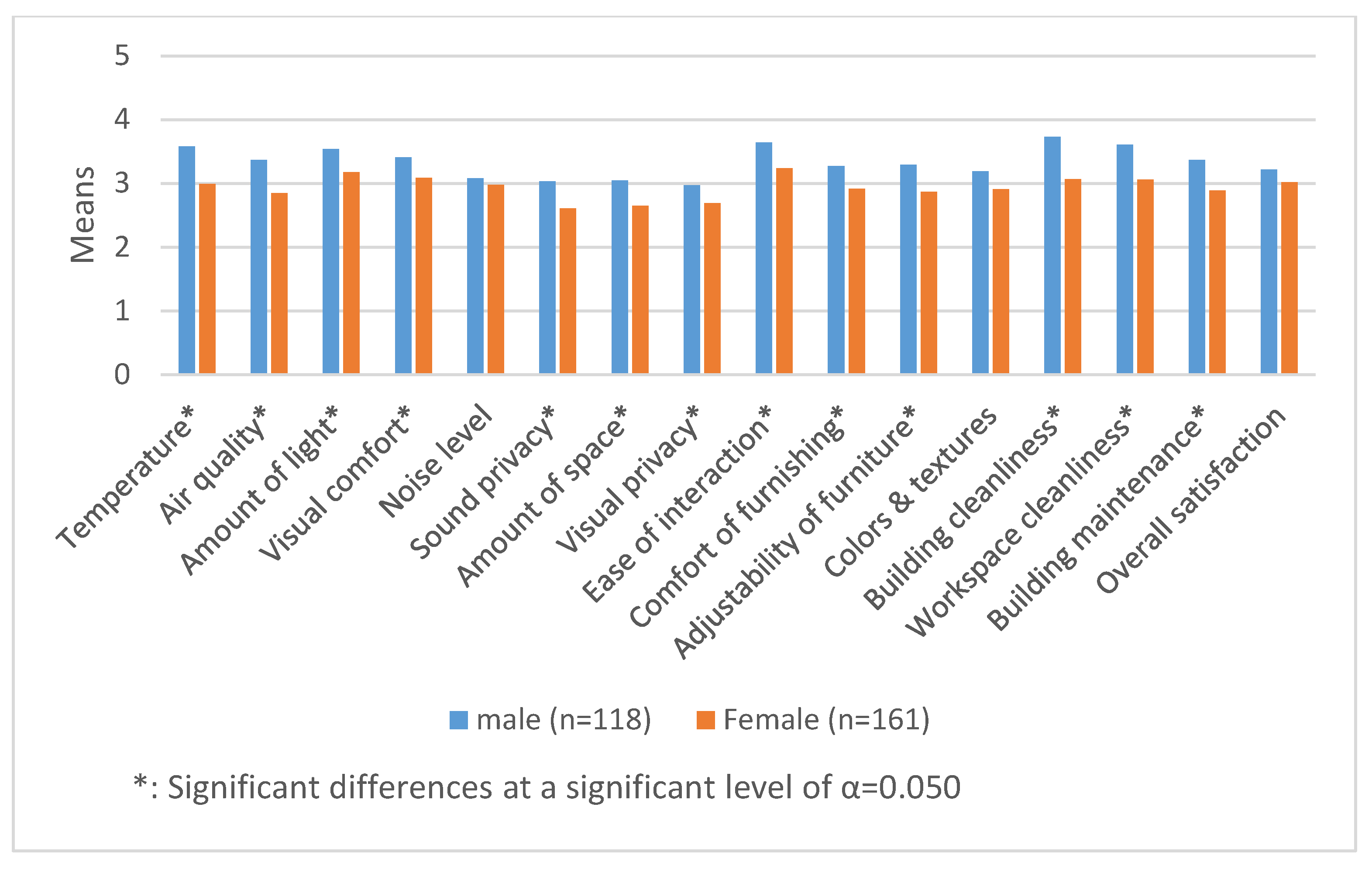
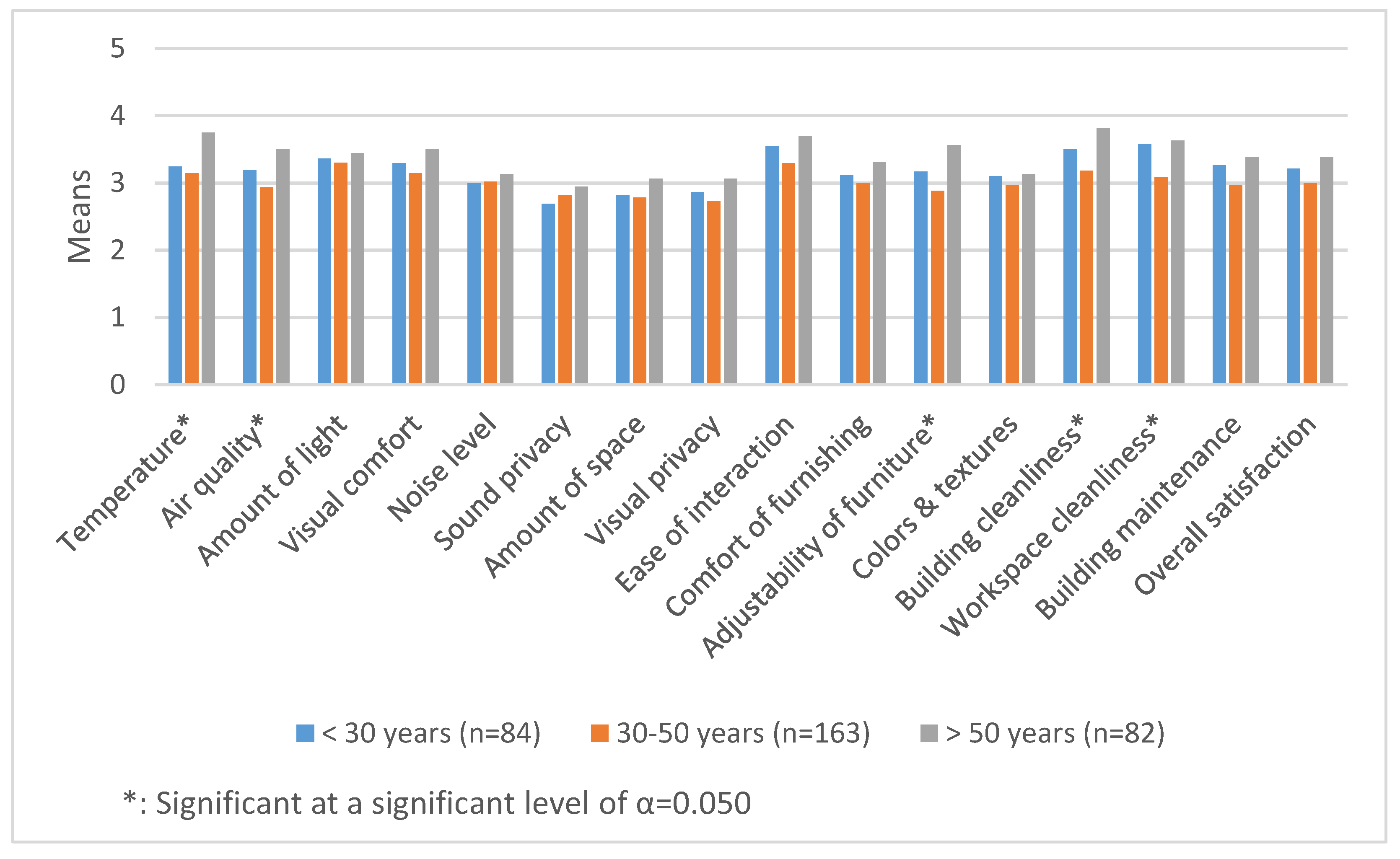
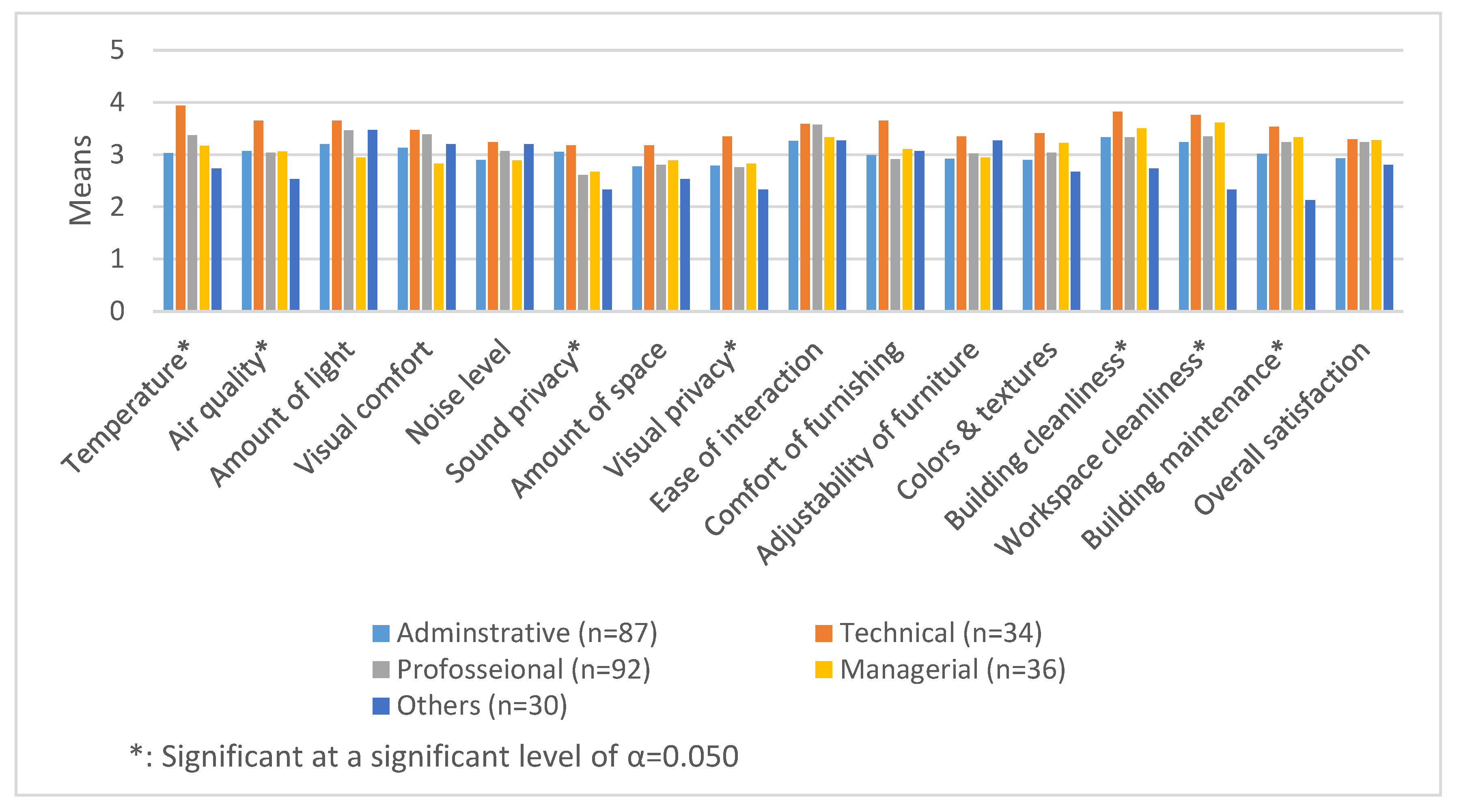
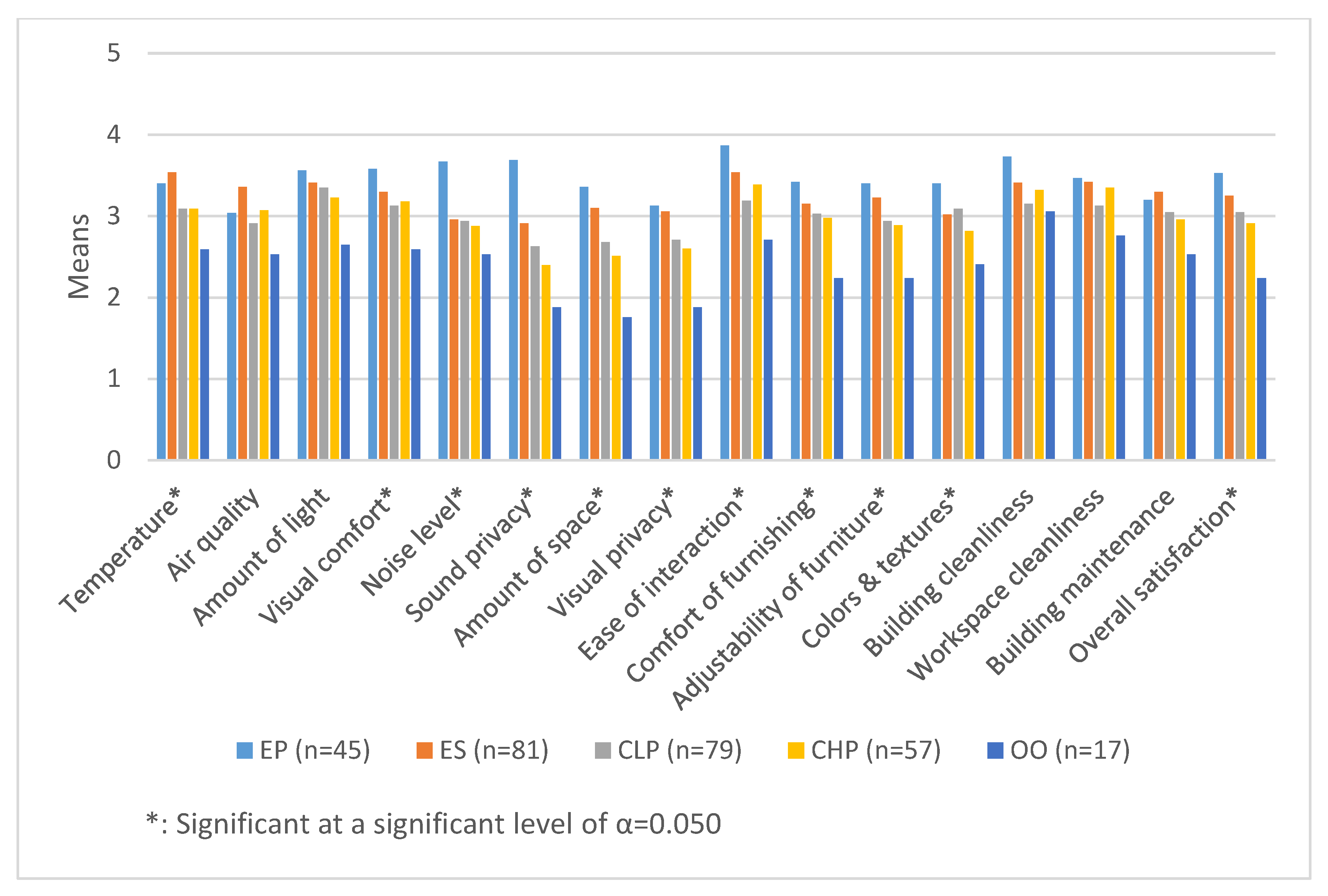
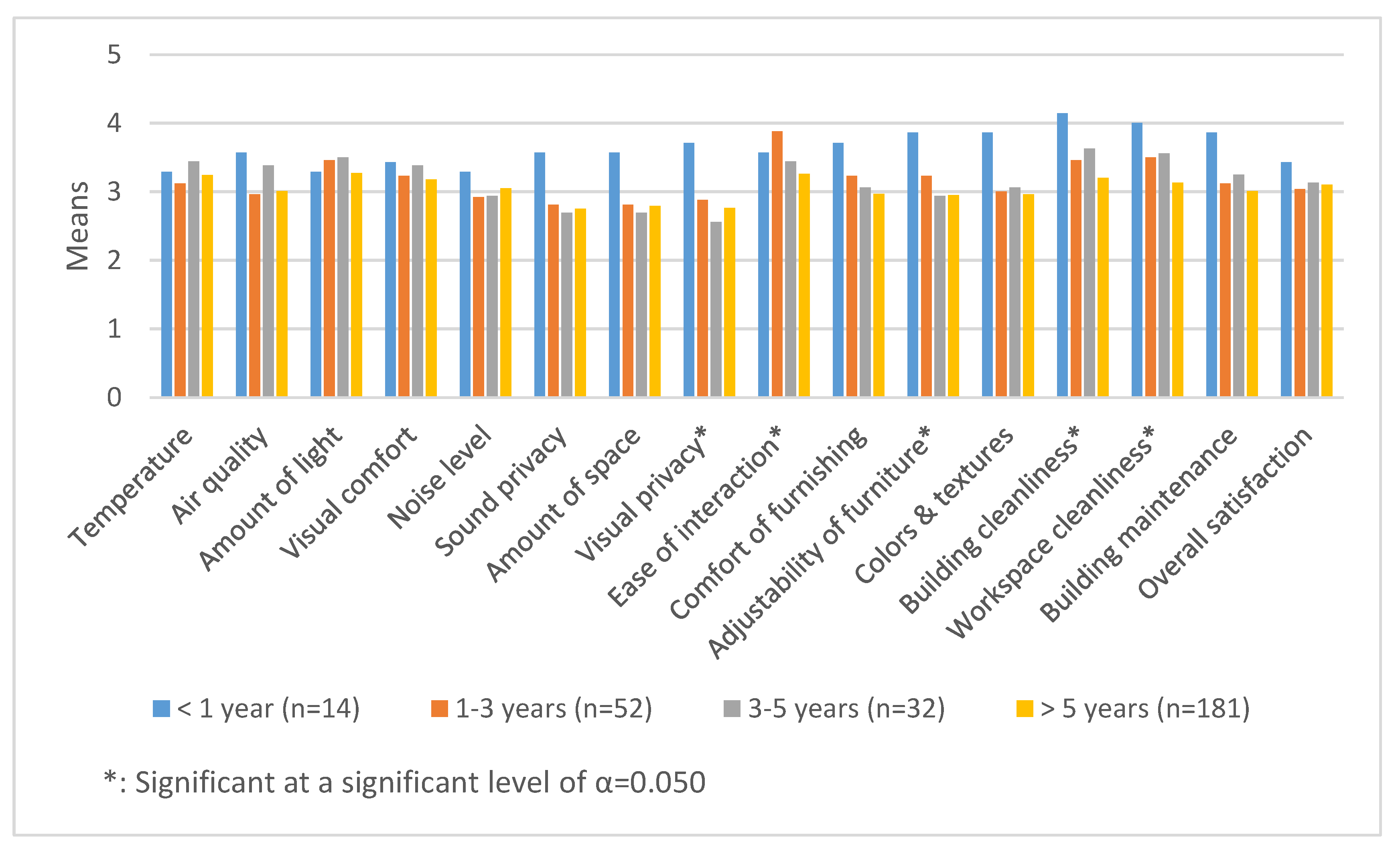
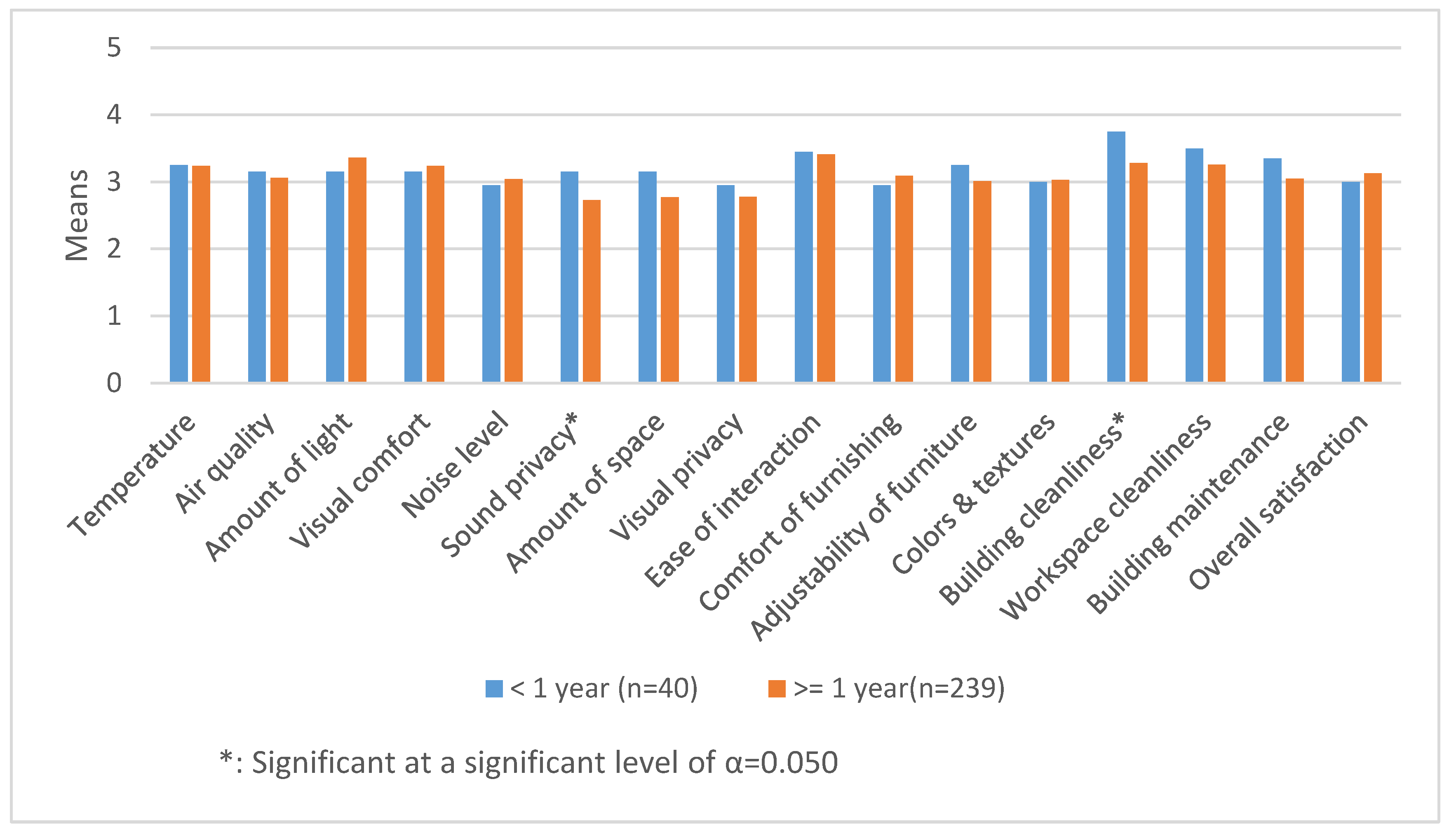
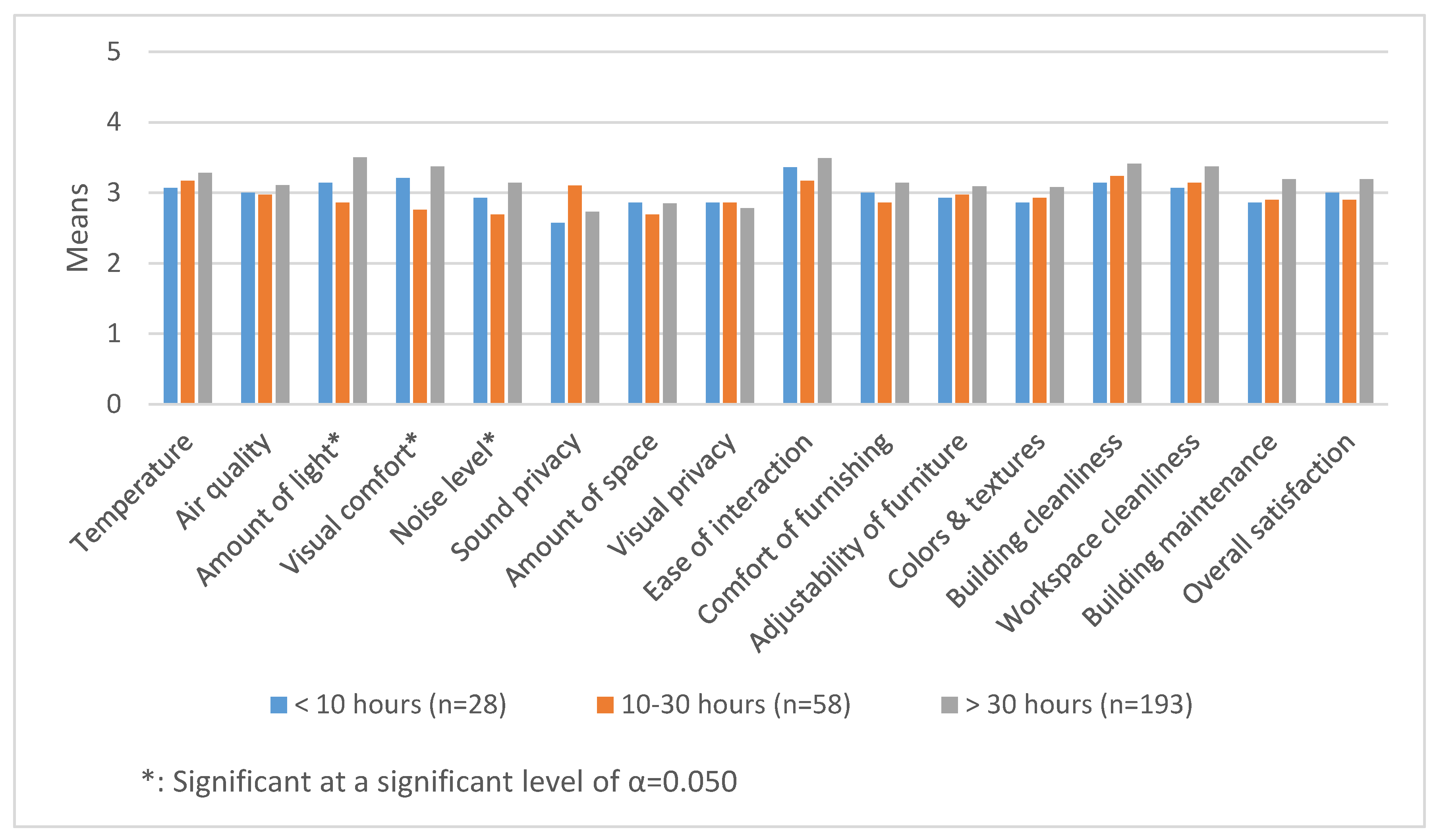
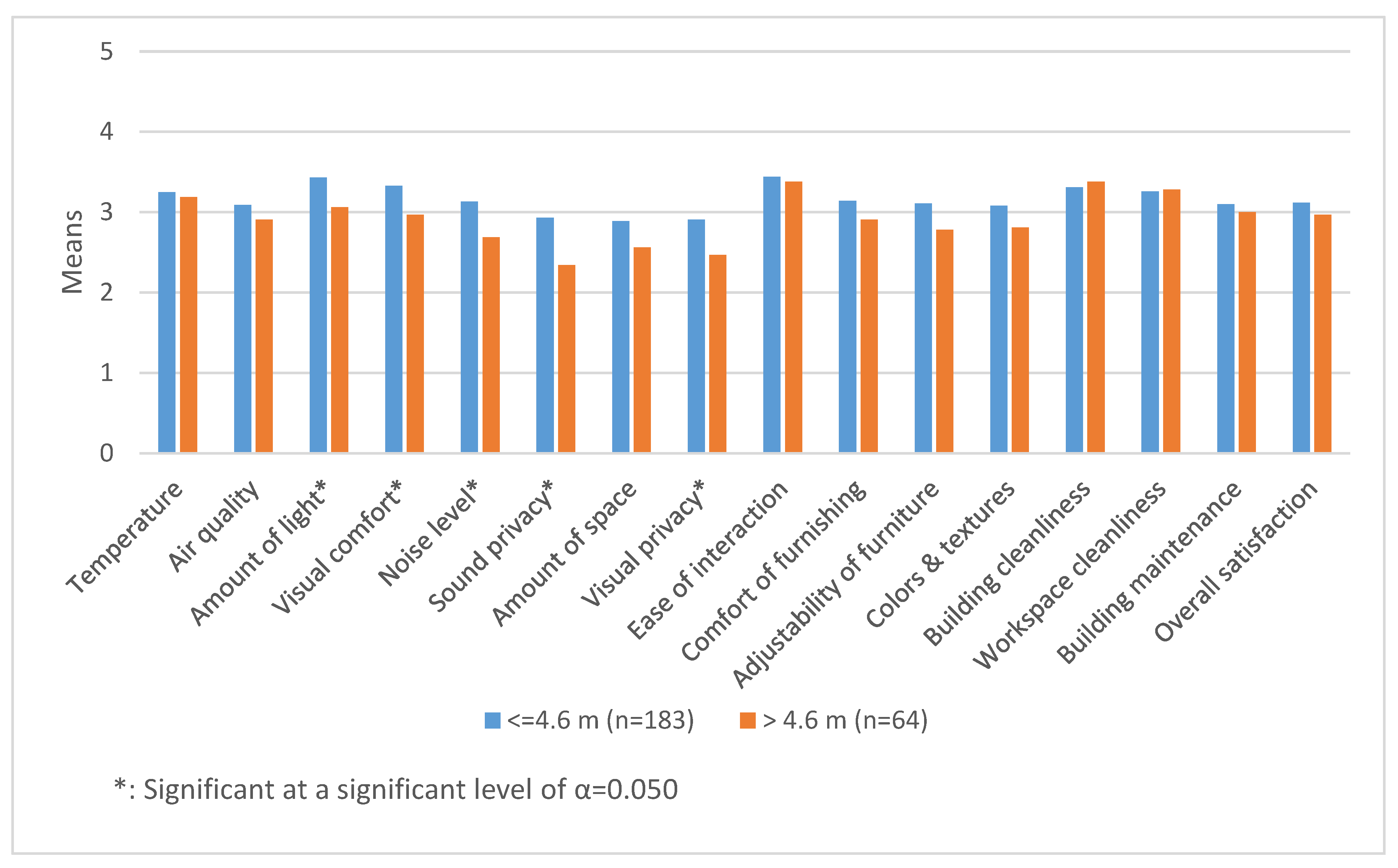
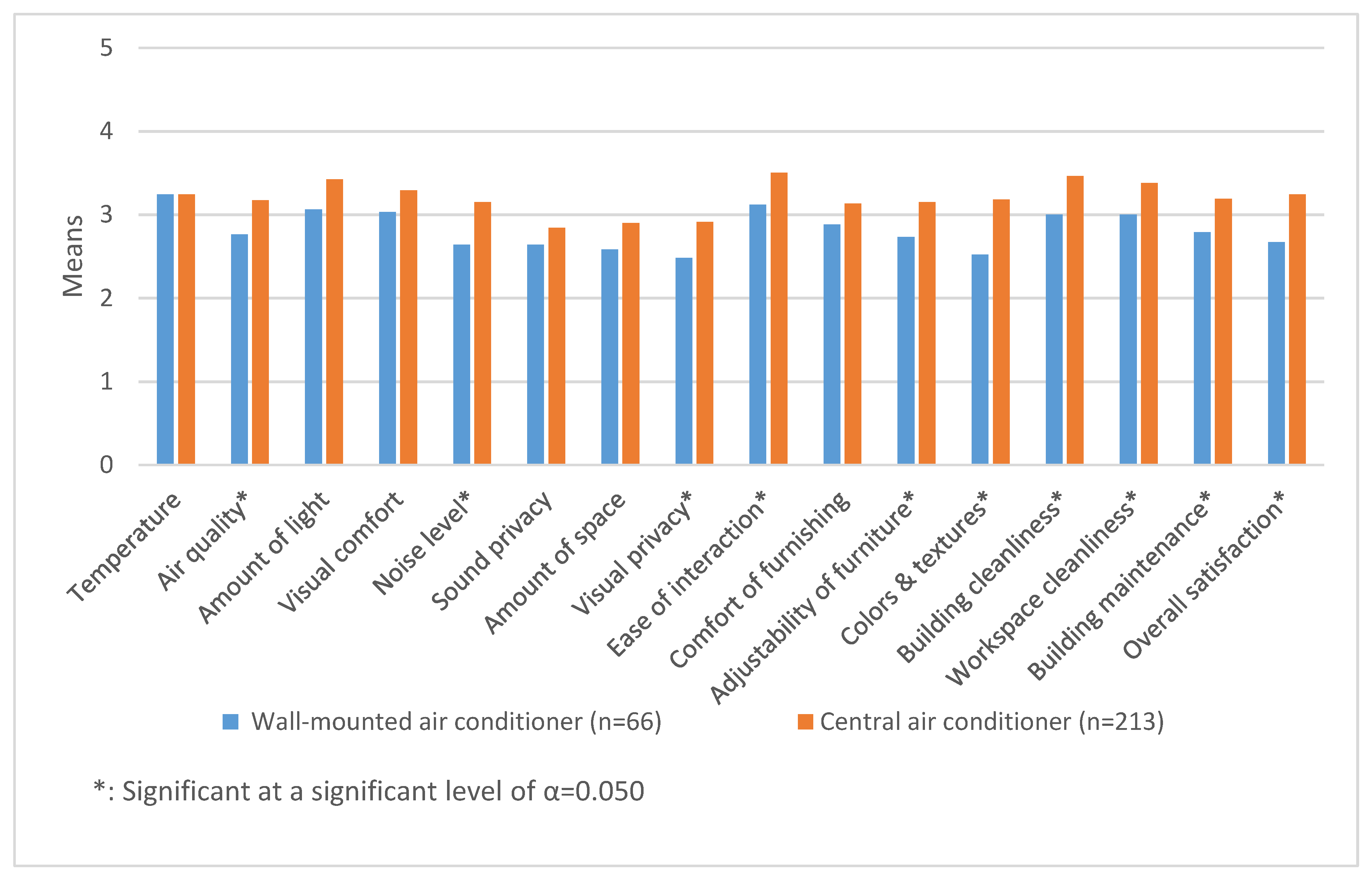
| Group | Item | Reference |
|---|---|---|
| Non-IEQ factors | Gender | [21,29,33,35,36,37,56,57,58,59] |
| Age | [21,29,33,35,36,37,58,59] | |
| Office Layout | [21,31,32,33,34,35,36,43,60] | |
| Job category | [21,33,35,36] | |
| Duration of working in the building | [21,29] | |
| Duration of working at the present workspace | [21,29,35] | |
| Time spent at workspace per week | ||
| Workstation’s distance from a window | [21,35,36] | |
| Ventilation system | [21] | |
| IEQ factors | Temperature | [30,34] |
| Air quality | ||
| Amount of light | ||
| Visual comfort | ||
| Noise level | ||
| Sound privacy | ||
| Amount of space | ||
| Visual privacy | ||
| Ease of interaction | ||
| Comfort of furnishing | ||
| Adjustability of furniture | ||
| Colors and textures | ||
| Building cleanliness | ||
| Workspace cleanliness | ||
| Building maintenance | ||
| Overall satisfaction |
| Non-IEQ Factor | Groups | Frequencies (%) |
|---|---|---|
| Gender | Male | 118 (42.3%) |
| Female | 161 (57.7%) | |
| Age | Less than 30 years | 84 (30.1%) |
| 30–50 years | 163 (58.4%) | |
| More than 50 years | 32 (11.5%) | |
| Job category | Administrative | 87 (31.2%) |
| Technical | 34 (12.2%) | |
| Professional | 92 (33.0%) | |
| Managerial-supervisory | 36 (12.9%) | |
| Other | 30 (10.8%) | |
| Office layout | Enclosed Private (EP) | 39 (14.0%) |
| Enclosed shared (ES) | 87 (31.2%) | |
| Cubicles with low partitions (CLP) | 79 (28.3%) | |
| Cubicles with high partitions (CHP) | 57 (20.4%) | |
| Open office with no partitions (OO) | 17 (6.1%) | |
| Duration of working in the building | Less than 1 year | 14 (5.0%) |
| 1–3 years | 52 (18.6%) | |
| 3–5 years | 32 (11.5%) | |
| More than 5 years | 181 (64.9%) | |
| Duration of working at the present workspace | Less than 1 year | 40 (14.3%) |
| One year or more | 239 (85.7%) | |
| Time spent at workspace per week | Less than 10 h per week | 28 (10.0%) |
| 10–30 h per week | 58 (20.8%) | |
| More than 30 h per week | 193 (69.2%) | |
| Workstation’s distance from a window | Within 4.6 m | 183 (65.6%) |
| Further than 4.6 m | 64 (22.9%) | |
| No window | 32 (11.5%) | |
| Ventilation system | Wall-mounted air conditioner | 66 (23.7%) |
| Central air-conditioning | 213 (76.3%) |
| IEQ Dimension | IEQ Factor | Mean | Std. Deviation |
|---|---|---|---|
| Thermal comfort | Temperature | 3.24 | 1.228 |
| Air quality | Air quality | 3.07 | 1.282 |
| Lighting | Amount of light | 3.33 | 1.190 |
| Visual comfort | 3.23 | 1.158 | |
| Acoustic quality | Noise level | 3.03 | 1.155 |
| Sound privacy | 2.79 | 1.226 | |
| Office layout | Amount of space | 2.82 | 1.219 |
| Visual privacy | 2.81 | 1.175 | |
| Ease of interaction | 3.41 | 1.229 | |
| Office furnishings | Comfort of furnishing | 3.07 | 1.232 |
| Adjustability of furniture | 3.05 | 1.241 | |
| Colors and textures | 3.03 | 1.216 | |
| Cleanliness and maintenance | Building cleanliness | 3.35 | 1.263 |
| Workspace cleanliness | 3.29 | 1.311 | |
| Building maintenance | 3.10 | 1.247 | |
| Overall satisfaction | Overall satisfaction | 3.11 | 1.192 |
| IEQ Factor | Odd Ratio | CI a (95%) |
|---|---|---|
| Temperature | 2.557 | [1.629–4.015] |
| Air quality | 2.119 | [1.373–3.271] |
| Amount of light | 1.699 | [1.101–2.625] |
| Visual comfort | 1.718 | [1.116–2.641] |
| Noise level | NS * | NS * |
| Sound privacy | 1.962 | [1.278–3.013] |
| Amount of space | 1.820 | [1.186–2.795] |
| Visual privacy | 1.554 | [1.015–2.382] |
| Ease of interaction | 1.865 | [1.209–2.872] |
| Comfort of furnishing | 1.711 | [1.114–2.627] |
| Adjustability of furniture | 1.927 | [1.254–2.962] |
| Colors and textures | NS * | NS * |
| Building cleanliness | 2.568 | [1.649–3.995] |
| Workspace cleanliness | 2.184 | [1.418–3.367] |
| Building maintenance | 1.994 | [1.293–3.074] |
| Overall satisfaction | NS* | NS * |
| IEQ Factor | Gender | Age | Job Category | Office Layout | Duration at Building | Duration at Workplace | Time Spent at Work | Distance to Window | Ventilation System |
|---|---|---|---|---|---|---|---|---|---|
| Temperature | * | * | * | * | |||||
| Air quality | * | * | * | * | |||||
| Amount of light | * | * | * | ||||||
| Visual comfort | * | * | * | * | |||||
| Noise level | * | * | * | * | |||||
| Sound privacy | * | * | * | * | * | ||||
| Amount of space | * | * | |||||||
| Visual privacy | * | * | * | * | * | * | |||
| Ease of interaction | * | * | * | * | |||||
| Comfort of furnishing | * | * | |||||||
| Adjustability of furniture | * | * | * | * | * | ||||
| Colors and textures | * | * | |||||||
| Building cleanliness | * | * | * | * | * | * | |||
| Workspace cleanliness | * | * | * | * | * | ||||
| Building maintenance | * | * | * | ||||||
| Overall satisfaction | * | * |
Publisher’s Note: MDPI stays neutral with regard to jurisdictional claims in published maps and institutional affiliations. |
© 2021 by the authors. Licensee MDPI, Basel, Switzerland. This article is an open access article distributed under the terms and conditions of the Creative Commons Attribution (CC BY) license (https://creativecommons.org/licenses/by/4.0/).
Share and Cite
Albuainain, N.; Sweis, G.; AlBalkhy, W.; Sweis, R.; Lafhaj, Z. Factors Affecting Occupants’ Satisfaction in Governmental Buildings: The Case of the Kingdom of Bahrain. Buildings 2021, 11, 231. https://doi.org/10.3390/buildings11060231
Albuainain N, Sweis G, AlBalkhy W, Sweis R, Lafhaj Z. Factors Affecting Occupants’ Satisfaction in Governmental Buildings: The Case of the Kingdom of Bahrain. Buildings. 2021; 11(6):231. https://doi.org/10.3390/buildings11060231
Chicago/Turabian StyleAlbuainain, Noora, Ghaleb Sweis, Wassim AlBalkhy, Rateb Sweis, and Zoubeir Lafhaj. 2021. "Factors Affecting Occupants’ Satisfaction in Governmental Buildings: The Case of the Kingdom of Bahrain" Buildings 11, no. 6: 231. https://doi.org/10.3390/buildings11060231
APA StyleAlbuainain, N., Sweis, G., AlBalkhy, W., Sweis, R., & Lafhaj, Z. (2021). Factors Affecting Occupants’ Satisfaction in Governmental Buildings: The Case of the Kingdom of Bahrain. Buildings, 11(6), 231. https://doi.org/10.3390/buildings11060231








